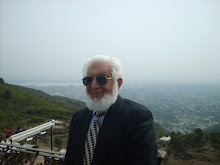No! I was never a good kabaddi player but my older brother was.
When I migrated from central India to Panjab Kabaddi and wrestling were the two most popular "big" games in the villages. "Keeping it Traditional" writer in Dawn describes the usual kabaddi (Kauoddi-in Panjabi), now more popular in Asia but it was more in Panjab then.
12 players on each side 7 active and 5 passive. Visitor from (the playing side) one side comes over , repeating with audible voice "kabaddi" and his plan is to touch any of the seven players standing away from the crossing line. After he has touched one or more players his startegy is to get back 'home' while his breath is still not broken. If his breath breaks or if he is cught by the one who was touched (only one-on one) and held until he his breath finishes he (dies) loses. If he is not caught and in that breath is able to force himself to cross the line he wins and the person touched "dies".
Another way of playing, considered more gallant, is with no "breath"
The visitor comes out stands facing (his) home and, kind of challenges any one to come and oppose him to try to get him and hold him while he struggles/forces himself back home by pushing him away. He has to take that chance of firm and fast push with both hands striking the opponent (usually in the chest) so he cannot catch him. On the other hand the "catcher" has his own plan of use of his legs taking a jump at the opponent and clasping his body/legs in his own two legs in the form of a scissors (qainchi) and then holding him till he gives up (cannot get out of the seizure)
My brother's fast movements were considered un-beatable as he was not a physically big man.
I had the only advantage of a longer breath but was physically not strong but I enjoyed playing in my village, never in serious match.
Please visit my Urdu blog at http://saugoreebsc.blogspot.com/ and my Hindi blog at http://wahajuana.blogspot.com/
Saugoree means I was born or I hail from Saugor This is the way they spelt the name of that city of my birth during British days of India. Then I moved at 11 years of age to Kotla a village in the Panjab close to the Kashmir border where I finished my initial education and childhood going on to Lahore for further studies where I got BSc and MBBS and then left for NWFP where I spent 2 1/2 years, teaching in the new Medical School, and from there leaving for UK and then USA
Search This Blog
Subscribe to:
Post Comments (Atom)

No comments:
Post a Comment